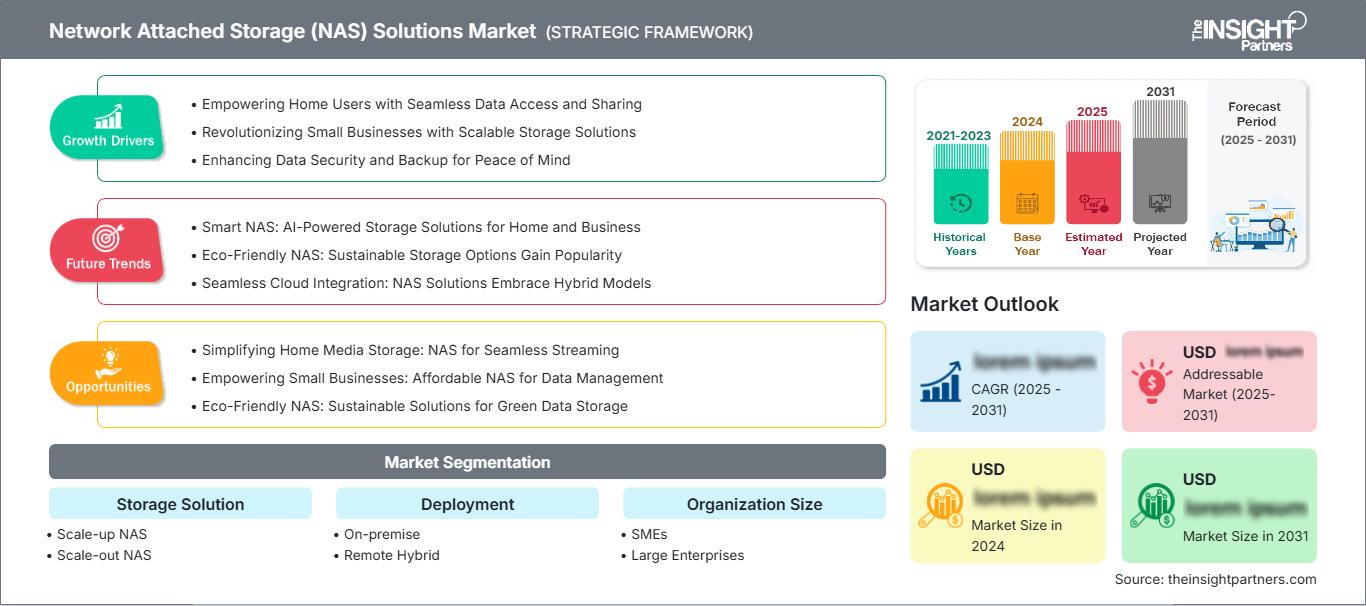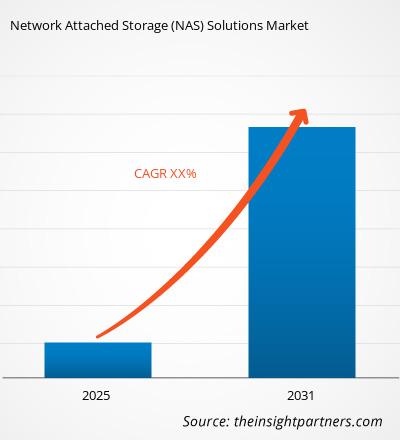Si prevede che il mercato delle soluzioni di storage di rete (NAS) registrerà un CAGR del XX% dal 2025 al 2031, con una dimensione del mercato in espansione da XX milioni di dollari nel 2024 a XX milioni di dollari entro il 2031.
Il rapporto è suddiviso in base alle soluzioni di storage (NAS scale-up, NAS scale-out) e analizza ulteriormente il mercato in base all'implementazione (on-premise, ibrida remota). Esamina inoltre il mercato in base alle dimensioni dell'organizzazione (PMI, grandi aziende) e al prodotto industriale (NAS aziendali di fascia alta, NAS di fascia media, NAS di fascia bassa). Per ciascuno di questi segmenti chiave viene fornita una ripartizione completa a livello globale, regionale e nazionale. Il rapporto include le dimensioni del mercato e le previsioni per tutti i segmenti, presentando i valori in dollari statunitensi. Fornisce inoltre statistiche chiave sullo stato attuale del mercato dei principali attori, insieme ad approfondimenti sulle tendenze prevalenti e sulle opportunità emergenti.
Scopo del rapporto
Il rapporto Network Attached Storage (NAS) Solutions Market di The Insight Partners mira a descrivere il panorama attuale e la crescita futura, i principali fattori trainanti, le sfide e le opportunità. Ciò fornirà spunti a vari stakeholder aziendali, come:
- Fornitori/Produttori di tecnologia: per comprendere le dinamiche di mercato in evoluzione e conoscere le potenziali opportunità di crescita, consentendo loro di prendere decisioni strategiche informate.
- Investitori: per condurre un'analisi completa delle tendenze in merito al tasso di crescita del mercato, alle proiezioni finanziarie di mercato e alle opportunità esistenti lungo la catena del valore.
- Enti di regolamentazione: per regolamentare le politiche e le attività di controllo sul mercato con l'obiettivo di ridurre al minimo gli abusi, preservare la fiducia degli investitori e sostenere l'integrità e la stabilità del mercato.
Soluzioni NAS (Network Attacked Storage) Segmentazione del mercato Soluzione di storage
- NAS scalabile
- NAS scalabile
Deployment
- On-premise
- Ibrido remoto
Dimensioni dell'organizzazione
- PMI
- Grandi Aziende
Prodotto
- NAS aziendale di fascia alta
- NAS di fascia media
- NAS di fascia bassa
Potrai personalizzare gratuitamente qualsiasi rapporto, comprese parti di questo rapporto, o analisi a livello di paese, pacchetto dati Excel, oltre a usufruire di grandi offerte e sconti per start-up e università
Mercato delle soluzioni di archiviazione di rete (NAS): Approfondimenti strategici

-
Ottieni le principali tendenze chiave del mercato di questo rapporto.Questo campione GRATUITO includerà l'analisi dei dati, che vanno dalle tendenze di mercato alle stime e alle previsioni.
Fattori di crescita del mercato delle soluzioni di storage collegato in rete (NAS)
- Offrire agli utenti domestici accesso e condivisione dei dati senza interruzioni
- Rivoluzionare le piccole imprese con soluzioni di storage scalabili
- Migliorare la sicurezza dei dati e il backup per la massima tranquillità
Tendenze future del mercato delle soluzioni di storage collegato in rete (NAS)
- NAS intelligente: soluzioni di storage basate sull'intelligenza artificiale per la casa e l'azienda
- NAS ecologico: le opzioni di storage sostenibili guadagnano popolarità
- Integrazione cloud senza interruzioni: le soluzioni NAS adottano modelli ibridi
Opportunità di mercato delle soluzioni di storage collegato in rete (NAS)
- Semplificare l'archiviazione multimediale domestica: NAS per streaming senza interruzioni
- Offrire alle piccole imprese: NAS conveniente per la gestione dei dati
- NAS eco-compatibili: soluzioni sostenibili per l'archiviazione dati ecologica
Mercato delle soluzioni di archiviazione di rete (NAS)
Le tendenze e i fattori regionali che influenzano il mercato delle soluzioni di Network Attached Storage (NAS) durante il periodo di previsione sono stati ampiamente spiegati dagli analisti di The Insight Partners. Questa sezione illustra anche i segmenti di mercato e la geografia delle soluzioni di Network Attached Storage (NAS) in Nord America, Europa, Asia-Pacifico, Medio Oriente e Africa, America Meridionale e Centrale.
Ambito del rapporto di mercato sulle soluzioni di archiviazione collegata in rete (NAS)
| Attributo del rapporto | Dettagli |
|---|---|
| Dimensioni del mercato in 2024 | US$ XX Million |
| Dimensioni del mercato per 2031 | US$ XX Million |
| CAGR globale (2025 - 2031) | XX% |
| Dati storici | 2021-2023 |
| Periodo di previsione | 2025-2031 |
| Segmenti coperti |
By Soluzione di archiviazione
|
| Regioni e paesi coperti |
Nord America
|
| Leader di mercato e profili aziendali chiave |
|
Densità degli operatori del mercato delle soluzioni di storage collegato in rete (NAS): comprendere il suo impatto sulle dinamiche aziendali
Il mercato delle soluzioni di storage di rete (NAS) è in rapida crescita, trainato dalla crescente domanda degli utenti finali, dovuta a fattori quali l'evoluzione delle preferenze dei consumatori, i progressi tecnologici e una maggiore consapevolezza dei vantaggi del prodotto. Con l'aumento della domanda, le aziende stanno ampliando la propria offerta, innovando per soddisfare le esigenze dei consumatori e sfruttando le tendenze emergenti, alimentando ulteriormente la crescita del mercato.

- Ottieni il Mercato delle soluzioni di archiviazione di rete (NAS) Panoramica dei principali attori chiave
Punti di forza
- Copertura completa: il rapporto analizza in modo esaustivo prodotti, servizi, tipologie e utenti finali del mercato delle soluzioni di storage di rete (NAS), offrendo una panoramica olistica.
- Analisi degli esperti: il rapporto è redatto sulla base della conoscenza approfondita di esperti e analisti del settore.
- Informazioni aggiornate: il rapporto garantisce la pertinenza aziendale grazie alla copertura di informazioni e tendenze dei dati recenti.
- Opzioni di personalizzazione: questo rapporto può essere personalizzato per soddisfare le esigenze specifiche del cliente e adattarsi in modo appropriato alle strategie aziendali.
Il rapporto di ricerca sul mercato delle soluzioni di storage di rete (NAS) può quindi contribuire a guidare il percorso di decodifica e comprensione dello scenario del settore e delle prospettive di crescita. Sebbene possano esserci alcune preoccupazioni valide, i vantaggi complessivi di questo rapporto tendono a superare gli svantaggi.
- Analisi storica (2 anni), anno base, previsione (7 anni) con CAGR
- Analisi PEST e SWOT
- Valore/volume delle dimensioni del mercato - Globale, Regionale, Nazionale
- Industria e panorama competitivo
- Set di dati Excel
Report recenti
Rapporti correlati
Testimonianze
Motivo dell'acquisto
- Processo decisionale informato
- Comprensione delle dinamiche di mercato
- Analisi competitiva
- Analisi dei clienti
- Previsioni di mercato
- Mitigazione del rischio
- Pianificazione strategica
- Giustificazione degli investimenti
- Identificazione dei mercati emergenti
- Miglioramento delle strategie di marketing
- Aumento dell'efficienza operativa
- Allineamento alle tendenze normative






















 Ottieni un campione gratuito per - Mercato delle soluzioni di archiviazione di rete (NAS)
Ottieni un campione gratuito per - Mercato delle soluzioni di archiviazione di rete (NAS)